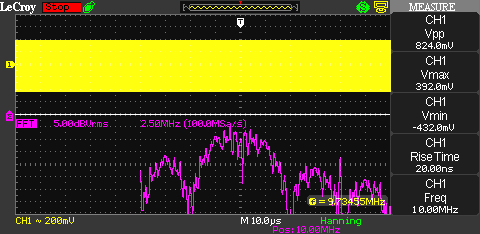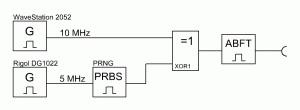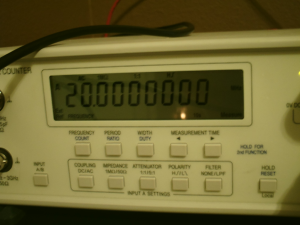Clock recovery in a Direct Sequence Spread Spectrum (DSSS) receiver can be quite a challenge. Because the clock recovery is crucial, this part of the receiver naturally determines the overall performance of the receiver. The Abracon ABFT, which I reviewed in a previous article, might be just the right Commercial Off-The-Shelf (COTS) device to get this job done.
There are two common approaches to recover the clock of a Direct Sequence Spread Spectrum (DSSS) signal, or BPSK modulated signals in general, for that matter. The first one is called a squaring loop and the second one is called a Costas loop.
The first technique relies on the fact that because the BPSK modulation causes ±180° phase transitions, the squared signal will have phase transitions of ±360°. The squared signal has now twice the frequency of the original carrier. If this signal is then being divided by two, the output signal will be phase coherent with the original carrier. BPSK and DSBSC signal carriers can be recovered in this fashion.
While this approach is mathematically the simplest, the practical implementation faces some hardships in the actual circuit designs.
The Costas loop is a PLL-based approach using an I/Q demodulator and two individual loops to control a single VCO [1]. The design is rather complex and I am not going into any detail here.
While I was reviewing the Abracon ABFT frequency translator / jitter attenuator, I was immediately curious if this device could lock onto the carrier of a BPSK modulated direct sequence spread spectrum signal. Why did I think it would work?
My first thought was that BPSK modulation can in a way be thought of as jitter. Remember, jitter is the undesired deviation from true periodicity of an assumed periodic signal. If you take a close look at the following BPSK modulated signal in the time domain, you can see where I am getting this idea.
My second thought revolved around the symmetry of a BPSK modulated signal. The power density of the BPSK modulated DSSS signal is the strongest around the original carrier frequency and declines from there off to the sides. The following picture shows that very well.
So the key question is: does the Abracon ABFT lock onto the carrier of a BPSK modulated DSSS signal? Well, the only way to find out is to try it!
In this experiment, I am using the same 127-bit Pseudo Random Number Generator (PRNG) that I have used in my previous article in which I took a closer look at a DSSS signal and its properties.
In my complete test setup I am using a LeCroy WaveStation 2052 waveform generator for the carrier, a Rigol DG1022 for the Pseudo Random Binary Stream (PRBS) clock rate, a TTi TF930 frequency counter and the LeCroy WaveStation 1022 for visualization. The two signal generators and the frequency counter are synchronized to a 10 MHz GPS-disciplined oscillator for highest accuracy and precision possible.
Here’s a blog diagram of my setup:
The whole setup became a bit messy but ah well, it got the job done!
Without anything connected to its input, the Abracon ABFT did put out a signal that is slightly below 20 MHz. Once I connected the DSSS signal, the ABFt immediately locked up and started to put out a rock solid 20 MHz signal. That’s right, not even 1 or .1 Hz off frequency! Now, how cool is that?
A closer look at the signal in the time domain proves that the output of the ABFT is twice the original carrier frequency, but otherwise phase coherent.
There is a bit of a delay on the bottom trace, but this is expected simply due to the higher delay in the physically longer signal path.
This article proves that it is often worth to think outside the box. Abracon did not design this device for this purpose in any way. There are many parts and pieces out there which can be used for all kinds of things they were not originally designed for.
So where do we go next? Well, I would love to bring this 10 MHz BPSK / DSSS demodulator in the shape of a single PCB and experiment further with it in an actual over the air application. Additionally, I would love to take a look at how well the ABFT does with QPSK and other M-ary PSK modulation. I did ask Abracon to supply some of those modules for the purpose of using them experimental PCB designs. I am hopeful they will respond positively to the request. Stay tuned!
Links & Sources:
[1] Costas Loop Implementation with Hypersignal Block Diagram/RIDE, National Instruments http://www.ni.com/
Westerhold, S. (2012), "DSSS / BPSK Clock Recovery with the Abracon ABFT". Baltic Lab High Frequency Projects Blog. ISSN (Online): 2751-8140., https://baltic-lab.com/2012/11/dsss-bpsk-clock-recovery-with-abracon-abft/, (accessed: April 18, 2024).
Funding:
If you liked this content, please consider contributing. Any help is greatly appreciated.






